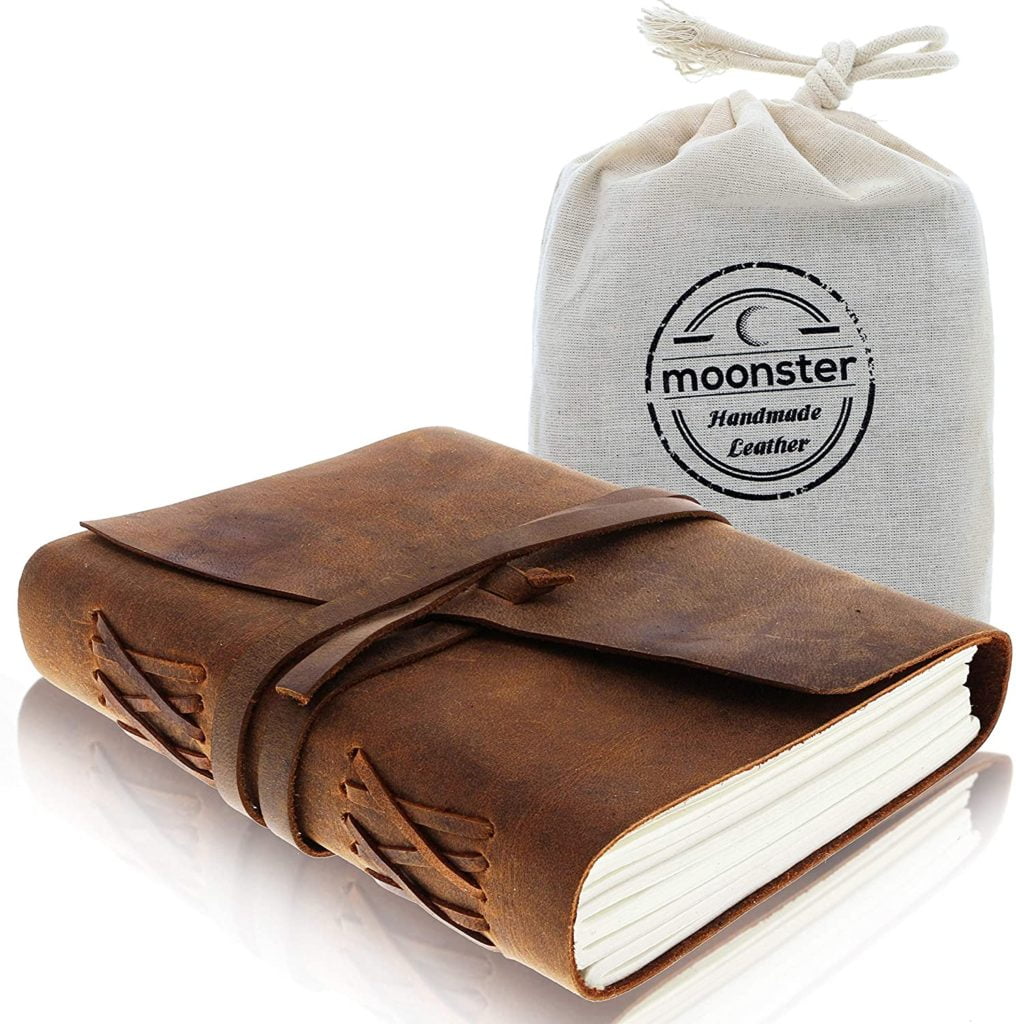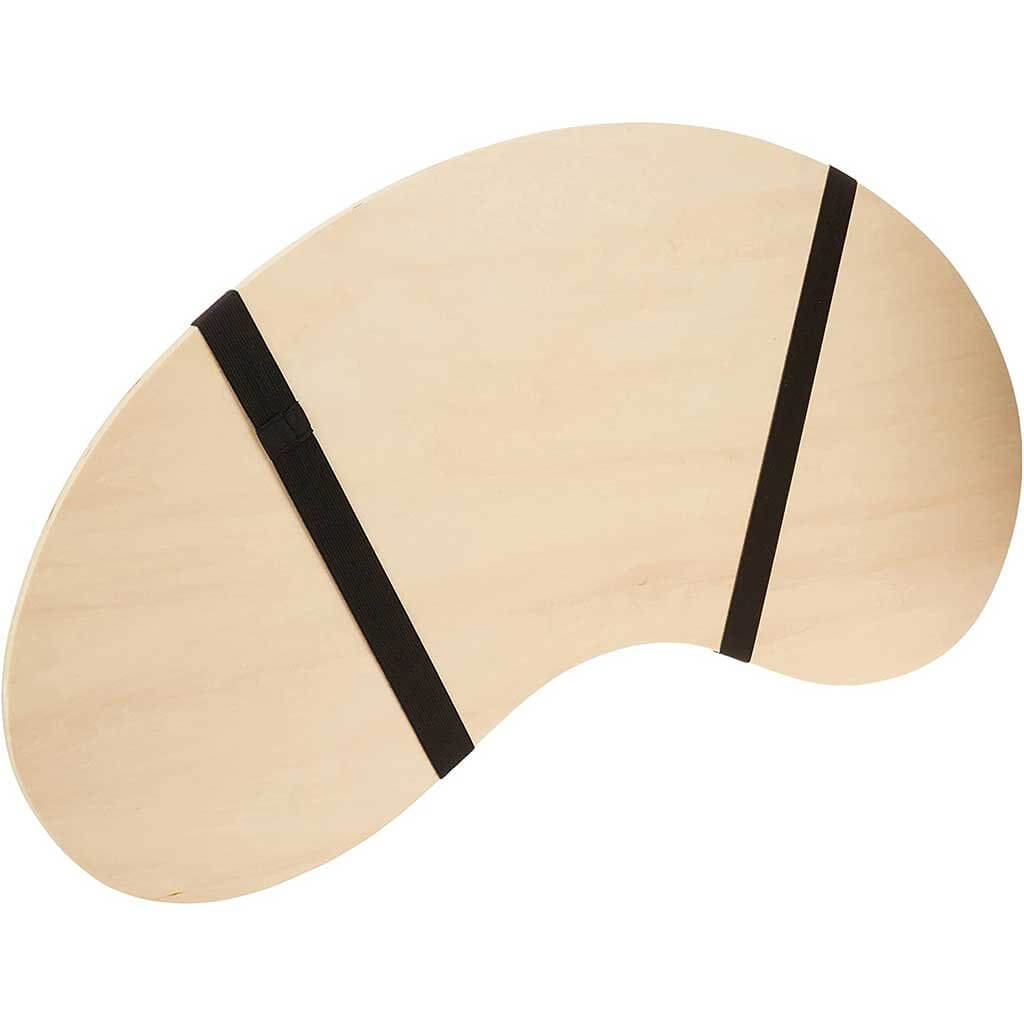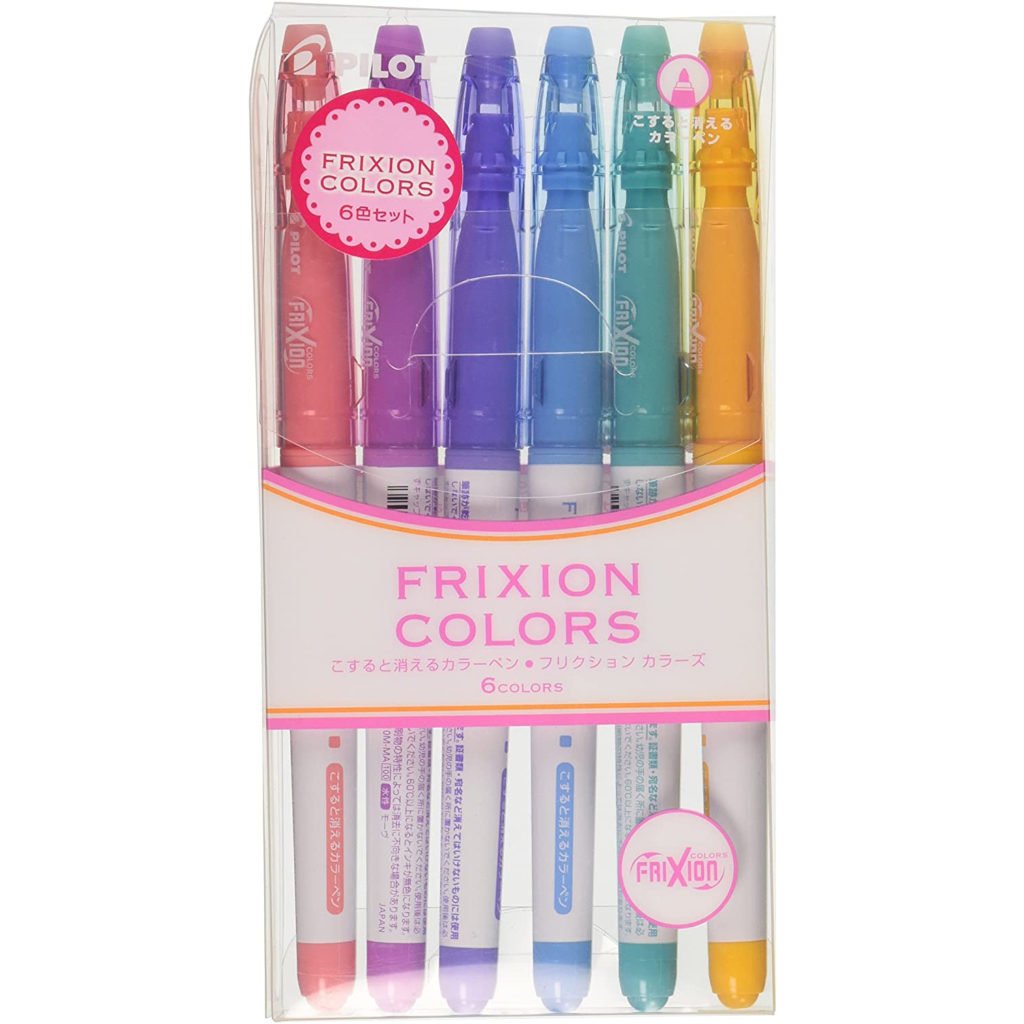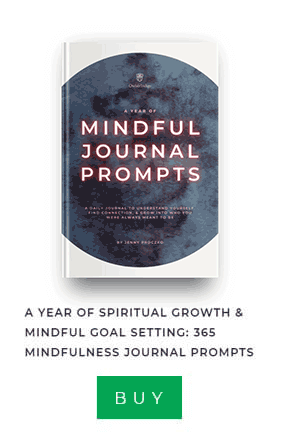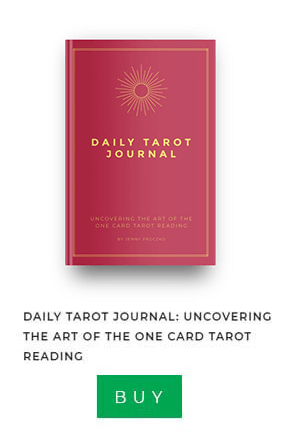Dream analysis and understanding was one of the first things I learned about as a teen searching for answers to understanding my place in the world, today it plays a major part in maintaining and managing my mental health. Dreams introduce us to the weird wild world of our subconscious, leaving us attempting to understand what it’s trying to tell us. Not only is the subconscious an odd place to be, this part of the brain talks in code and what seem like secret symbols. You have undoubtedly seen a million books on dream interpretation in each book store you walk into. While helpful, they often fail to reach the root of understanding our dreams, leaving out a crucial part of dream journaling: post dream analytical analysis.
What is the process of dream journaling? Dream journaling is the process of recording and analyzing your dreams to uncover truths to your subconscious mind. Most commonly this type of journaling requires a book where you record your dreams as best you can remember upon waking up. Then analyze the imagery of your dreams including locations, people, feelings, symbols, to learn more about yourself.
Knowing what your sleeping mind is trying to say is confusing at best. But I have found the best way to uncover the secrets your subconscious is trying to tell you in your dreams. So, break out your journal and come along with me into the night time world of your dreams.
Table Of Contents:
- 5 Habits To Help You Remember Your Dreams
- How To Analyze Your Dreams: The Process
- Total Recall & Post Dream Analysis
- Helpful Dream Analysis Hacks
- What Dreaming About A Black Cat Means
- Dream Journal Shadow Work Journal Prompts
- What Do Dreams Reveal About Your Subconscious?
- Other Forms Of Dream Analysis & Interpretation
- What Role Do Dreams Play In Your Life?
What Is A Dream Journal?
Keeping a dream journal is a priceless gift to your future self. A dream journal or dream diary is a type of reflective journal, where you record your experiences you dream about while you are asleep; And then meditate on what they mean through dream analysis and dream interpretation. Dream Journals help you understand what your dreams mean, including recurring dreams, nightmares, night terrors, sleep paralysis episodes, and other types of dreams
The Goal Of A Dream Journal
Along with setting the intention to remember your dreams (which we’ll get into in a minute), you can also set a goal for your dream journal. Depending on the goal you choose, it will dictate the type of information you include in your dream journal or how detailed your entries will become. Some types of dream journal goals include:
- Understanding your thoughts and emotions
- Putting your sleep cycles back into balance
- Problem Solving
- Controlling Lucid Dreams
Benefits Of Recording Your Dreams
Dream journaling helps build cognitive bridges between your awake self and your sleeping dream self. In essence, a dream journal helps you discover and get to know your inner self.
1. Discover & Understand Your Inner Self
2. Build Mental Stamina
3. Strengthen Your Emotional Intelligence
4. Control Your Dreams
Think about it, you have certainly “seen” yourself in your dreams, and you always look different from what you see in the mirror when you’re awake. A really cool idea that I came across while learning about dream journaling and lucid dreaming is to make it a practice in lucid dreams to look in the mirror to see who I am and what I look like. It’s never the same!
Keeping a dream journal can also help build your mental stamina for memory and strengthen your emotional intelligence by helping you regulate your thoughts and emotions in times of stress.
Building and honing these skills will help you confront any waking issues you are having, and uncover underlying ones that you might not have known about. This always leads to delicious enlightening “ah ha” moments.
Keeping a dream journal can also help you learn how to control your dreams with lucid dreaming, leading to more good dreams and fewer bad dreams. Dream journals also bring out our creative sides, helping us foster our inner artist and employ creative problem solving.
How Keeping a Dream Journal Benefits Your Waking Life
- Helps Improve Memory
- Better Understand Your Emotions, Thoughts, &
- How They Affect You
- Learn To Control Your Dreams With Lucid Dreaming
- Creative Problem Solving
- Correct Your Sleep Cycles
- Reveal Dream Patterns
- Break Creative Blocks
- Insight Into Your Interior Life
- Fuel Your Creativity
- Process Your Emotions
- Rehearse Your Response To Stressful Situations
How To Choose A Dream Journal
Choose a journal or notebook that you love and a pen that you enjoy writing with. This can be a spiral notebook from the dollar store or a sturdy leather bound journal from your favorite book store. This journal needs to be exclusively for recording your dreams, that means, no daily planner, no daily task lists, no gratitude journal, no bullet journaling, only record your dreams in this journal.
Additional items that you might not even realize you need are a book light and something to rest on like a lap desk. It will happen that you wake up in the middle of the night and want to record a dream. Use a booklight to keep from waking up your partner. Don’t wait to record your dream until morning, trust me. Too many amazing dreams and brilliant ideas have slipped through the cracks of night never to be seen or remembered again. Here is my favorite leather journal, celestial journal, pen, book light, and lap desk.
Things You’ll Need To Start Dream Journaling
- A Dream Journal
- Pens, Pencils, Or Markers
- Book Light
- Something To Rest On
Some links in this article are affiliate links, this means I earn a small commission if you use them! Affiliate Links are one way I am able to provide videos, articles, and resources for free. Other links go straight to the Owls & Indigo Shop where you can support me directly.
Setting Up A Dream Journal
Before you can even dive into dream analysis, there is prep work that needs to be done. Open your journal to a fresh two page spread. The goal when setting up your dream journal is to make it easy to analyze your dream journal contents at-a-glance. On the right page, split your page into two columns, and in the rightmost outside column, write the following 6 sections:
- Location
- People
- Feelings & emotions
- Symbols
- Theme
- Dream Type
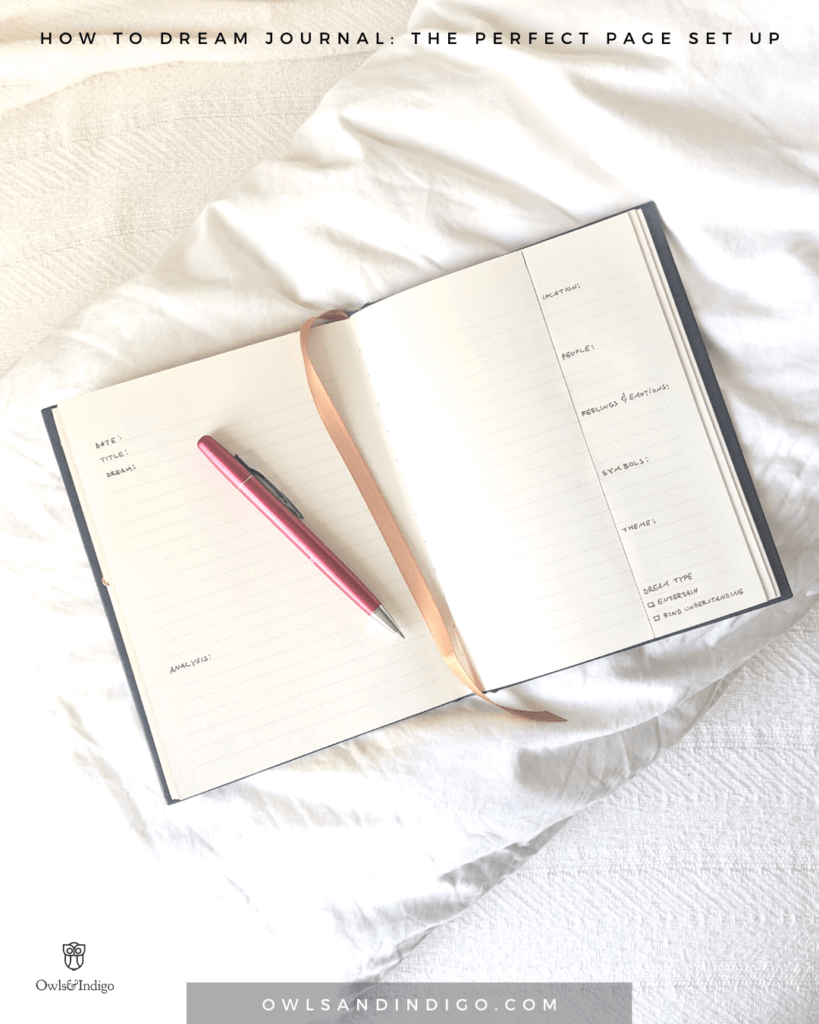
The left column on this right hand page will be extra space for writing, analysis, or sketching.
At the very bottom of the right hand page ask yourself “was your subconscious: entertaining you? Or working through something? I like to make these two questions check boxes when I’m setting up my journal pages for the next morning.
On the left hand page include these sections:
- Date
- Title
- Dream
- Analysis
Write the date, then leave space for titling your dream which you will do later, and then space for analysis at the very bottom of the page. Sometimes my analysis section is on a later page depending on how much of the dream I remembered while journaling.
Leslie Ellis, Ph.D. therapist and dream expert says, “It can also help to make little sketches of your dream as they are often highly visual,” she adds, “and pictures can convey spatial relationships often depicted in dreams.” Try including space for sketching a scene from your dream on these pages. Don’t discount the power of images in your Dream Journal.
How To Remember Your Dreams
Having total recall of your dreams is not something that is easy at first, recording dreams starts with patience. With practice and consistency you’ll be able to remember all of your dreams and understand what they mean. It all boils down to two things:
- Each night as you get into bed, set an intention to remember your dreams, by committing to building a habit of recording your dreams as soon as you wake up.
- Record your dreams every day that you have them.
“Our brains are highly susceptible: if you decide that you want to remember your dreams and interiorize this intention every night before falling asleep, you will see your memory improving and soon you will have much better dream recall.”
Sílvia Bastos
But before you obtain total recall and after you’ve set up your journal the night before, you’ll need to establish some mini habits to help you remember every juicy detail.
5 Habits To Help You Remember Your Dreams
- Prep your journal ahead of time or at least the night before
- Set your journal and pen beside your bed so it’s the first thing you see when you wake up.
- Set a consistent wake up alarm for the same time everyday.
- Don’t hit snooze or you’ll lose the dream.
- Record your dream in list format in the first 5 minutes of waking up before you get out of bed. Don’t worry about writing your dream out in detail, just do a list braindump or mental inventory of your dream.
If you still have trouble remembering and recording your dreams, take this into consideration: The simple act of resetting your daily life habits can realign your intentions and boost your ability to remember your dreams. So try resetting your daily habits for a fresh start.
An avid dream journaler noticed that their dream recall came in waves. They would record six dreams in a row, and then their journal sat blank and dormant for a while. So what happened? Most often than not, the dream recordings occurred at the beginning of the week after they had reset their general daily life habits.

How To Analyze Your Dreams: The Process
It’s the morning after you prepped your journal and you have just experienced a doozy of a dream. You’re probably feeling like you got hit by a ton of bricks, your body is sore, or you’re at least waking up confused by what your subconscious has just shown you.
“Suspended in the liminal state between wakefulness and sleep, the sliver of time after waking seems to be the only part of the day when we’ve been soaked in our interior lives for hours on end without external influences. Dream journaling is one way to capture the unfettered thoughts, emotions and images arising from this state of mind for a moment longer.”
Charmaine Li
1. Utilize Bullet Point Lists To Remember Your Dreams
Shake off the stunned look on your face and reach for your journal, it’s time to write as quickly as you can so you don’t lose any information from your dream. To boost your dream recall, quickly write a list of details in each of the sections in your journal: Location, People, Feelings & Emotions, Symbols, Theme.
For example when trying to recall the dream’s location, just write a list of places you remember:
- School
- Classroom
- Bedroom
- Home
- Work
- Childhood Home
- Ex’s Apartment
- The Woods
- Under Water
- In A Fast Moving Car
No need to go into detail just yet. The fact you can write all this down will help make the dream a more concrete memory.
Do this for each section in your dream journal spread.
2. Describe Your Cast Of Characters
Next, write a list of the people you were with, even if you don’t know who they are. Sometimes in our dreams there are characters that have names, but aren’t a part of our waking life or reality. Often these people don’t have faces, or are part animal, or even talking animals! Whoever it was in your dream, write down their names, or quick descriptions like faceless man, or talking cat, the dream version of your partner etc.
No matter how vivid your dreams are, as you wake up, if you don’t make an effort to record them, they will often disappear into the ether as you wipe the sleep from your eyes and go about your day.
Therefore, it is extremely important and crucial that you make a daily effort to ask yourself to remember what you dreamed about last night and then record them. This simple act executed on a regular basis can help exponentially with improving total dream recall.
When you are writing and recording your dream, suspend your judgement and any notions of correcting your grammar including first, second, and third person perspective. Feel free to switch from past tense to present tense and back again, the main goal is to get it all out.
Just write in as much detail as you can and as fast as you can to get it all out, no detail is too trivial. This dream journal method is very similar to a bullet journal brain dump or mental inventory. Make sure to include your internal experience too, this is what you were thinking or feeling during the dream. Sometimes what seems like worthless details now, turn out to be highly significant later when you’re reviewing your dream journal.
If your hands are cramping, pen ink is running dry, and you can’t write fast enough then you should try recording your dreams via audio or typing. I have found that typing my dreams can be helpful in getting out my thoughts as fast as possible. My fingers are always flying extremely fast across the keys as I record the previous night’s dreams. There are days when typing is the only way that I can keep up with the thoughts and memories of the dreams running through my head as I attempt to record them.
“Dreams are not prophecies. They are mirrors to our subconscious mind and they’re highly individual.”
Eric Sangerma
A Note On Your Dream Partner or Spouse: This can go one of two ways. Commonly when we refer to our “dream guy” or “dream partner” we’re talking about an abstract idealized version of what we want in a partner. This is something that we consciously think about. However, when people talk about their “dream partner” in reference to their dreams, they are talking about an alternate reality version of their actual partner. Commonly in dreams, our partners are on extreme ends of the spectrum of good and evil.
There have been many mornings where I have woken up pissed off at my husband because “Dream Dan” was a total dickhead to me in my dream. I’ve even jokingly told my partner Dan that he needs to have a talk with “Dream Dan” and straighten him out. This “evil” version of my spouse usually surfaces in my dreams when we’ve had a fight or if I’ve been feeling stressed out for a while. For me, when this version of my evil partner comes up in my dreams, it’s a signal that I need to take some time for myself and destress.
3. Let All Your Feelings Come To The Surface
Now that you have a list of the scene and cast of characters of your dreams, quickly write a list of your immediate feelings and emotions while in the dream and when you woke up. It’s okay to feel self conscious or embarrassed about recording the feelings and emotions in your dream. No matter what they are, write down your true feelings even if they are judgmental, accusatory or embarrassing. These dreams are not real life. By recording our feelings and emotions in their true form, we are laying the groundwork to confront them, own them, and re-write the story for why they exist. This gives us better understanding and insight into what makes us think and feel.
4. Describe The Symbols In Your Dream
Next, quickly write a list of symbols that occurred in your dream. These can be literal symbols like glyphs, runes, road signs, etc. Also write down any common dream symbols like, animals, babies, losing teeth, crosses, exams, etc. Or more abstract ideas and symbols like, being chased, death, falling, jumping, faulty machinery, sex, nudity, being trapped, etc.
5. Determine Your Dream Themes
Now write down a list of themes that you think your dream might fit under. You may or may not know what your dream’s theme is at this point in time. If you don’t know, then leave it blank.
These lists should have taken no more than five minutes after waking up.
6. Weird & Juicy Dream Details
Next write out a quick outline of what happened in your dream. Short hand will be your friend here, remember you want to get out as much information from your dream as possible before it fades into the ether. This outline should take no more than 3-5 minutes.
Make sure to include enough detail in your outline so that when you revisit this entry at a later date you will be able to recall the dream in question.
7. Entertaining Dreams vs Working Through Some Heavy Shit
Lastly, decide what your subconscious mind was trying to do with that dream: was it trying to entertain you? Or work through something to help you find better understanding?
This entire process so far should take you less than 10 minutes to complete.
Total Recall & Post Dream Analysis
Now, if you have the time, write out your dream in as much detail as you can remember. Include rich detail, dialogue, colors, feelings, emotions, write down everything.
Once you have completed your post dream analysis remember to title your dream at the top of the page. This is super important! When you title your dream, it reduces the dream down to a quick descriptive summary making it easier to recall it later as you flip through your journal.
Forcing yourself to sum up your dream into a theme of a few words or phrases will help you get a better grasp on the practice of dream journaling. When giving your dream a title, try capturing the main feeling, emotion, or theme behind it. Later on you might even discover unintentional puns or admissions that crack your understanding of the dream wide open.
Helpful Dream Analysis Hacks
1. Personalize your dream journal with different symbols and colors that have specific personal meaning to you. This is a kind of shorthand that is easy to glance at and understand, much like a bullet journal key.
2. Color code your dream journal by using highlighters to “tag” your journal with categories or type of dreams like “lucid dreams” and “non-lucid dreams.” These are some of my favorite erasable highlighters and markers that I use for highlighting and underlining while color coding in my journals.
3. Compare your dreams to your IRL experiences. When you look for patterns in your dreams that align with your waking moments, they can begin to reveal what your subconscious is thinking about.
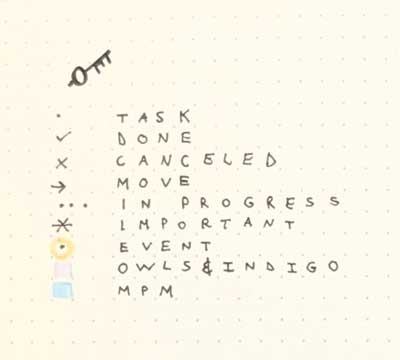
When I was first introduced to dream journaling and dream analysis, I stayed in bed and wrote down everything before my feet touched the ground for the first time in the morning. I did this to build the habit and flex the muscle of dream recall and memory.
Now that I have gotten used to recalling my dreams in outline format, I can do a quick mental inventory brain dump of the dream’s Location, People, Feelings & Emotions, Symbols, and Theme, and jump out of bed. Then I’ll get ready for the day, get myself a cuppa, and sit back down with my dream journal to begin phase 2 and write down my dream in detail before I get into dream analysis.
How to Analyze Your Dreams
Next it’s time for Dream Analysis! This can be daunting if you have a weird list of symbols and places. However, I find that this is the most important and most fun aspect of dream interpretation. There are countless manuals, guides, and ‘dream dictionaries’ out there, but it’s only you who can make sense of your dreams. There is no uniform interpretation that applies to everyone.
“I believe it to be true that dreams are the true interpreters of our inclinations; but there is art required to sort and understand them.”
Montaigne (Essays III)
Dream Dictionaries can only go so far, and don’t include cultural meanings to the vast array of symbols in the human experience. Most dream dictionaries are from the Western World perspective, which is why it’s important to define what certain symbols mean to your culture and more specifically and most importantly, what the symbols mean to you.
For example: A Black Cat Dream Meaning
Everyone dreams and everyone thinks, but understanding those thoughts and dreams vary from person to person. For one person the black cat is an evil omen that brings feelings of death and destruction. This is why dreaming is an inherently subjective and deeply personal singular experience. No two dreamers are alike, everyone’s dreams and ways of thinking are intrinsically different.

What Dreaming About A Black Cat Means
Take a look in any dream dictionary and it will tell you that to see a black cat in your dream indicates that you are experiencing fear, bad luck, destruction and Evil. Sounds pretty scary doesn’t it? That one dream meaning alone might send you in a tailspin trying to uncover what your subconscious was trying to tell you, while you spend the rest of your day fearing what evil is headed your way.
That is the common cultural definition of a black cat, steeped full of superstition and dark brooding energy. But that is not what a black cat means to me.
You need to apply your particular life experience to the dream symbols you see. You can’t rely on what the masses say about one thing or another. You need to dig deep and think for yourself. What does this symbol mean to you? Or to your family? Or to your way of life?
For me a black cat represents love, beauty, a friend, a familiar, and a partner at various points in my life. Black cats are often misunderstood and thought to be evil omens, but that is not what a black cat means to me. Black cats in my life represent positivity.
As you can see, it is extremely important to take what you read in a dream dictionary with a grain of salt, and be sure to apply your own life experience to the symbols you see in your dreams. Afterall, the symbols are coming from your subconscious, not a collective consciousness that is following a particular dream dictionary.
When analyzing your dreams after you have written them down in detail, you need to take into account your life experience. If you really are stumped, use a dream dictionary for inspiration. But remember you don’t really need a dream dictionary, you just need a deeper understanding of yourself and what makes you tick. Which is what dream analysis and interpretation is all about.
Dream Journal Shadow Work Journal Prompts
If you have consulted a dream dictionary and you’re still feeling stuck, dig a little deeper with these shadow work journaling prompts that you can apply to your post dream analysis in your dream journal.
- What do these elements mean to you personally?
- What kind of associations do you have with them?
- How did you feel when you woke up?
Remember, only you know what a dream might mean to you. This kind of self-inquiry coupled with deep reflective Shadow Work can help peel back the layers of a dream and reveal the dream’s meaning over time. Sometimes even instantly.
What Do Dreams Reveal About Your Subconscious?
Dreams are a way your subconscious mind communicates with your waking conscious mind. Often when our waking life gets stressful or doesn’t go the way we want, our subconscious is there for us and tries to give us what we crave by allowing them to play out in our dreams in the form of symbols, mysterious meanings, and associations.
In the past I have had extremely magical dreams with so much depth, vivid landscapes and people, that were steeped in artistic beauty, sounds and touch. When my dreams are this vivid, I know that my subconscious is trying to communicate with me, leaving valuable messages in the form of breadcrumbs, from my innermost true self, my shadow self, waiting to be deciphered.
“A dream journal is an invaluable source of psychological insight.”
Kelly Bulkeley Ph.D
Not only do these dreams serve as a signal that I need to do some self reflecting, they are also sources of endless inspiration and ideas for creative projects that I’m working on. Keeping a dream journal has given me the keys to a castle and the ability to access a well of pure creativity deep within my subconscious mind.
This access to my true self and creative identity is something that feeds my soul and helps me feel connected to myself, others around me, and nature. Oftentimes my dreams teach me empathy and creativity, giving me a safe place to explore, fail, create, and improve, which lead to various degrees of feeling connected.
Other Forms Of Dream Analysis & Interpretation:
Journaling is not the only form of dream analysis. There are so many different options available to you! The most similar technique to journaling and writing, is to record your dreams with audio. It’s as simple as opening a voice note on your phone the moment you wake up, and hit record as you recount your dream. There are also audio recording apps for android and all other operating systems, if your phone doesn’t automatically have the capability to record voice notes.
Other Creative exercises to record your dreams for interpretation and analysis are :
- Automatic Writing
- Drawing Or Painting Your Dreams
- Staging A Photoshoot To Enhance Your Dreams
- Using Movement And The Body With Interpretive Dance And Choreography To Bring Your Dreams To Life
- Recreating Meals Or Food From Your Dreams In Your Kitchen
These additional practices provide a better understanding of your dreams and make use of your five basic senses. By using hearing, sight, touch, smell and taste you are solidifying and committing your dreams to your memory in a more tangible way. I often pair drawing with my dream journal because sketching out my dreams is not only a creative outlet, it also helps me to visualize my dreams when I come back to them years later.
What Role Do Dreams Play In Your Life?
As seekers, mankind has the tendency to need to know the truth. But with dreams, we can’t be truth seekers, there is no definitive way to interpret our dreams with exact certainty… yet. Who knows what secret inner workings of the subconscious and the mind that science will unlock in the future. For now, all we can do is speculate what dreams mean based on shared cultural symbols, and what they mean, specifically to us.
I have now gotten to the point where I am able to easily tell what my subconscious is trying to tell me. “Entertainment Dreams” are easy to spot and just be amused by. Which means that more important dreams are easy to spot too, leaving me space to reflect and dig deeper to understand what my subconscious was trying to tell my waking mind.
Dream Analysis and Interpretation is a fascinating way to get a keep behind the curtain and really understand what makes you tick.
Remember When Dream Journaling: List, Outline, Detail, Analyze.


